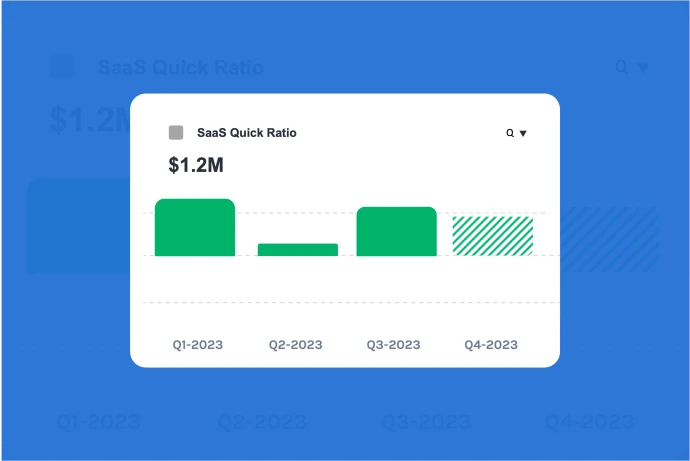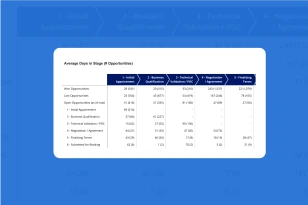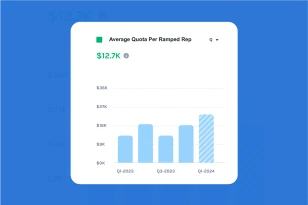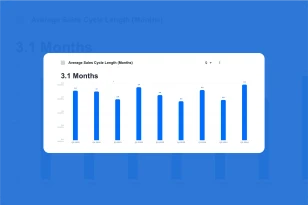What is SaaS Quick Ratio?
SaaS Quick Ratio measures a company’s ability to grow its recurring revenue despite churn. It compares a company’s revenue inflows (new and expansion) to its revenue outflows (churn and contraction) to show net revenue growth.
Why is it important to measure SaaS Quick Ratio?
The SaaS Quick Ratio holds significance for several reasons:
- Financial Health Indicator: The metric serves as a key indicator of the company’s financial health. A high SaaS Quick Ratio implies that the company is efficiently generating revenue that exceeds its variable operating expenses, contributing to financial stability.
- Profitability Assessment: It assesses the profitability of the company’s revenue generation. A favorable SaaS Quick Ratio suggests that the revenue generated is of high quality, meaning that it contributes significantly to covering fixed costs and achieving profitability.
- Operational Efficiency: The SaaS Quick Ratio reflects the company’s operational efficiency in converting revenue into profit. It provides insights into how well the company manages its costs and generates a surplus from its SaaS offerings.
- Investor Confidence: Investors and stakeholders often look at financial metrics like the SaaS Quick Ratio to gauge the company’s financial viability and growth potential. A positive ratio can instill confidence in investors and attract additional investment.
How do you calculate SaaS Quick Ratio?
SaaS Quick Ratio Formula
(New ARR + Expansion ARR)/ absolute value (Churn ARR + Downgrade ARR)
How do you improve SaaS Quick Ratio?
Improving the SaaS Quick Ratio involves strategies to increase revenue efficiency and manage variable operating expenses more effectively. Here are some approaches to enhance this metric:
- Pricing Optimization: Review and optimize the pricing strategy for SaaS offerings. Consider adjusting pricing tiers, bundling options, or introducing value-added features to maximize revenue while maintaining customer satisfaction.
- Customer Segmentation: Analyze customer segments to identify high-value customers. Focus marketing efforts on attracting and retaining customers who contribute significantly to revenue. Tailor offerings and incentives to meet the needs of these segments.
- Cost Management: Implement rigorous cost management practices to control variable operating expenses. Negotiate favorable terms with suppliers, explore cost-effective technology solutions, and streamline operational processes to reduce variable costs.
- Upselling and Cross-Selling: Encourage upselling and cross-selling opportunities to existing customers. Identify opportunities to offer additional features, modules, or services that align with customer needs, thereby increasing the average transaction value.
- Efficient Sales Processes: Streamline sales processes to reduce the time and resources required to close deals. Implement efficient lead nurturing, shorten sales cycles, and invest in sales automation tools to enhance the overall efficiency of the sales team.
- Productivity Improvement: Enhance the productivity of SaaS delivery teams. Implement tools and technologies that improve efficiency in product development, deployment, and support, ensuring that variable expenses are managed effectively.
- Customer Retention Strategies: Prioritize customer retention to reduce the costs associated with acquiring new customers. Implement customer loyalty programs, provide excellent customer support, and address customer feedback to enhance satisfaction and retention.
- Investment in Scalability: Invest strategically in technologies and infrastructure that allow the SaaS company to scale efficiently. Scalability ensures that the company can handle increased demand without proportionally increasing variable operating expenses.
- Data-Driven Decision-Making: Utilize data analytics to make informed decisions about revenue generation and cost management. Analyze customer behavior, market trends, and operational data to identify areas for improvement and optimization.
- Continuous Monitoring and Adjustment: Regularly monitor the SaaS Quick Ratio and adjust strategies accordingly. Market conditions, customer preferences, and industry trends can change, so continuous adaptation is essential for sustained financial health.





